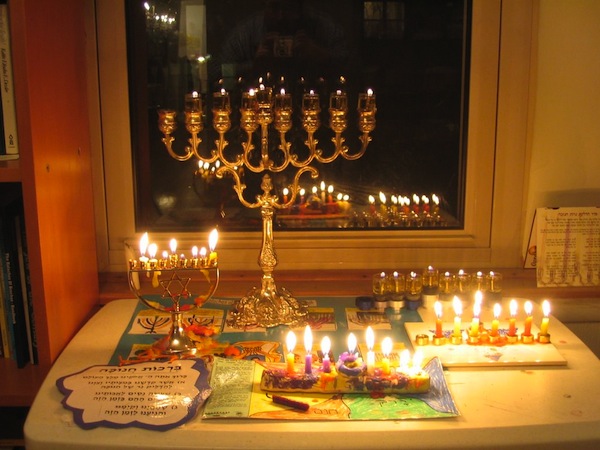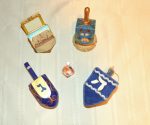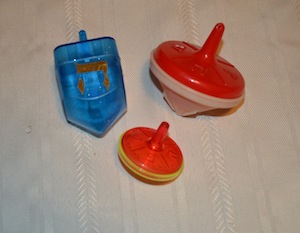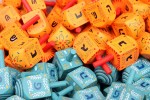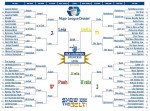The lights of chanukiyot could be seen in the neighbourhood windows. (photo by Neil Harris/uberdox.aishdas.org)
There once was a dreidel named Dreidelhead. Dreidelhead had three brothers and lived with his parents in Flushing, N.Y. His first name was Noon but everyone just called him Dreidelhead because his head and body were shaped like a big dreidel. His three brothers were named Gimel, Hay and Shin.
Dreidelhead’s parents taught all of the children how to sing, dance and, of course, spin. So, during the holiday of Chanukah, all four children would sing, dance and, of course, spin at Chanukah parties and celebrations in their neighbourhood. Noon, Gimel, Hay and Shin would link their arms together and dance around the chanukiyah, singing Chanukah songs. It was quite a sight to see, the four dreidel brothers dancing together and spinning around the table. Everyone, especially children, loved to watch them.
Dreidelhead, like his brothers Gimel, Hay and Shin, was named after a Hebrew letter. Each brother had their letter stitched onto the front of their shirt, so that, when people saw them standing together, people would be reminded of the great miracle that occurred.
Dreidelhead’s letter, Noon, represented the word nes, miracle. Gimel’s letter represented gadol, which means great. Hay’s letter represented hayah, which means happened, and, finally, Shin’s letter, which is one of the last letters of the Hebrew alphabet, represented sham, the Hebrew word for there. So, when Noon, Gimel, Hay and Shin stood together, they reminded people that Nes gadol hayah sham, a great miracle happened there, in Israel, many years ago.
On the first night of Chanukah, after lighting the candles and singing songs, and before they were about to eat the scrumptious latkes that their mother and bubbie had made, Dreidelhead’s zaide would always tell the boys the story of the miracles that took place during the Festival of Lights. As their mom put down a plate of golden brown potato pancakes on the table and some sticky jelly doughnuts, their zaide recounted the tale of a band of Jewish rebels named the Maccabees, who were led by Mattityahu, a Jewish priest, and his five sons.
“A long time ago,” Zaide began, “there was an evil king of Syria named Antiochus, who forbade the study of Torah and wanted Jews to bow down to idols and eat pork. He also put idols right in the Holy Temple in Jerusalem.”
“I’d rather eat latkes and jelly doughnuts than pork,” Dreidelhead announced as he glanced hungrily at the plate of steaming latkes and sufganiyot.
“Yeah, me too,” chimed in Hay.
“Well, you’ll be eating some soon, just let your zaide finish his story,” Dreidelhead’s mom interjected.
“But, we already know the story of Chanukah,” Dreidelhead whined. “We learn it in Hebrew school every year.”
“I know you do,” Zaide patiently replied. “So, nu, if you know the story, tell us what happened next.”
“Well, um, the Maccabees, who were led by Judah the Maccabee (the Hammer) overthrew Antiochus and came to the Holy Temple to light the menorah and to cleanse it of all of the idols that were placed in it. When they came to light the menorah, there was only enough oil to last one night, but a miracle occurred and the oil lasted for eight days and eight nights,” Dreidelhead replied all in one breath.
“And so what do we do to commemorate the miraculous victory and the miracle of the oil?” Zaide asked.
“Well,” replied Dreidelhead, “uh, well, we light the candles for eight nights and put the chanukiyah in the window, we tell the story of Chanukah and eat potato latkes fried in oil. And we can also eat jelly doughnuts fried in oil. That’s what they do in Israel. Oh, yeah, and dreidels like us spin on Chanukah!”
“Don’t forget the part about the Chanukah gelt,” Gimel said.
“Oh, yeah,” said Dreidelhead. “We also get money or Chanukah gelt.”
“That’s true,” Zaide replied. “But, try to remember, boys, that the most important part of Chanukah is not getting money or presents, but lighting the candles, remembering the story and the miracles, and spinning for children during Chanukah. In fact, before your bubbie and I came to America, we would spin for all of the children in our little village in Russia on Chanukah.”
“Your zaide’s right boys,” Bubbie piped in. “And, back in the Maccabees’ time, according to an old legend, we dreidels were used to warn students studying Torah that Antiochus’s troops were coming.”
“So our ancestors helped save people’s lives – they were heroes!” exclaimed Hay.
“That’s right,” Dreidelhead’s father acknowledged. “So, you boys should be proud to be dreidels. Anyway, after you thank your bubbie and zaide for their wonderful Chanukah stories, I want you to wash your hands and then you can eat. You’ll need lots of energy if you’re going to dance for the boys and girls in the neighbourhood tonight.”
Later that evening, the dreidel brothers roamed the neighbourhood searching for Jewish families who were celebrating Chanukah. They were easy to find. The dreidels just looked for houses that had a chanukiyah displayed on the windowsill. They knocked at people’s doors and announced in unison, “Happy Chanukah! It’s the dreidels!” If there were any children in the household, they would jump up and down and shout at the top of their lungs, “The dreidels are here! The dreidels are here!” The children would plead with their parents to invite the dreidels into their home. Once inside, the dreidels would spin and sing for the children, just as their parents and grandparents did before them.
And so, during the eight nights of Chanukah, while the candles were burning, Dreidelhead and his brothers would dance and spin, bringing joy wherever they went.
David J. Litvak is a prairie refugee from the North End of Winnipeg who is a freelance writer, former Voice of Peace and Co-op Radio broadcaster and an “accidental publicist.” His articles have been published in the Forward, Globe and Mail and Seattle Post-Intelligencer. His website is cascadiapublicity.com.

